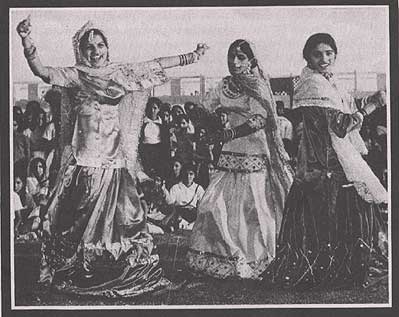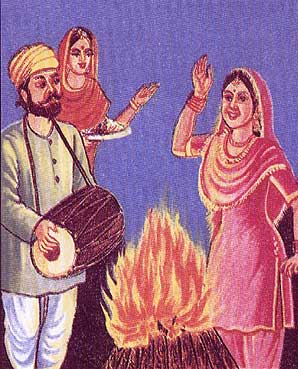
One
evening a bevy of village maidens meet in the home of one of their friends. They
are all very excited. One of them says impatiently, "For heaven's sake let's
go, it's getting dark!" "What's the great hurry?" asks another.
"There are still another eight days to Lohri." The others protest, "Only
eight! Let's get the others and start on our rounds."
There is much shouting
and yelling of names. Soon almost all the girls of the village between twelve
and thirteen years of age are assembled. "Which house do we start with?"
asks one. Various suggestions are made. Ultimately they decide on the village
headman's home.
The girls gather round his house and chant: We've come,
all the girls of the village! We've come to your courtyard, O headman!
Jito,
the headman's daughter opens the door and offers them a cow-dung cake. "We
won't take one," protest the girls. "Yours is the first house we've
visited. You must give us five."Jito's mother tells her to give them five
dung-cakes. "Why don't you come with us?" ask the girls, taking the
cakes. Jito loves to sing and dance. She asks her mother if she can go out with
the girls. Her mother agrees, "Take your cousin Harjeet with you. She has
never seen how we celebrate Lohri in Punjab."
And so they go from house
to house collecting cow-dung cakes till they have a veritable pile. They deposit
all of them inthe headman's house and return to their homes.
The next morning
Harjeet asks her aunt, "Why do the girls collect these cow-dung cakes?"
"Lohri
is celebrated on the last day of the month of Pans to mark the end of winter,"
replies her aunt. "It is said that our forefathers formulated a sacred mantra
which protected them from the cold. This mantra invoked the Sun God to send them
so much heat that the winter cold would not affect them. And, in thanks-giving
to the Sun God, they chanted this mantra round a fire on the last day of Pans.
The Lohri fire is symbolic of the homage to the sun. A song is sung on this occasion:
Where have the shawls and braziers gone?
To the golden mountain Where's the
golden mountain gone?
To the sun's ray Where has the sun's ray gone?
To
the sun Where's the sun gone?
To the fire The fire burns, the ray warms
The
snows melt, the cold days have ended.
Our ancients believed that the flames of the fires they lit took their message to the sun, and that is why on the morning after Lohri, which is the first of the new month Magh, the sun's rays suddenly turn warm and take the chill out of our bones.

"There
is also another version of Lohri. In olden times, human beings lit fires to keep
away flesh-eating animals and protect their habitations. Everyone contributed
to this communal fire, for which young boys and girls collected firewood from
the jungle. That is why even today when we burn cow-dung cakes it is teenagers
who go around collectingthem. The Lohri bonfire is symbolic of our old method
of protecting ourselves as well as a form of fire worship. It is to the Lohri
fire that couples pray for more children and parents for husbands for their unmarried
daughters. When people throw sesame seeds in the fire they ask for sons. The saying
is: As many as the elder brother's wife throws, so many sons the younger brother's
wife will bear. That is why in homes where there is a new-born son or a newly
wed man, Lohri is celebrated with even greater enthusiasm, and sweets made of
molasses and sesame seed are sent to relatives and friends. Since the Punjabi
word for sesame seed is til and for molasses rorhi the festival is also called
Tilori. Lohri is also an occasion when parents give presents to their newly married
daughters. "For peasants, Lohri marks the beginning of a new financial year
because on this day they settle the division of the products of the land between
themselves and the tillers." So ended the aunt's long lecture on Lohri. Meanwhile
different parties of girls were going from door to door singing Lohri songs and
asking for things. From bridegrooms' homes they asked for gur (molasses) and at
the homes of the new-born they sung songs of blessing.
On the eve of Lohri
the most popular songs sung by groups of boys invariably end with the exclamation
'ho':
It is a pretty ring, ho! Who owns you, ho! Dulla of village Bhatti,
ho!
Dulla married someone's daughter, ho! And so on.
Since Lohri is
also associated with weddings, many Lohri songs are based on the old love story
of Dulla Bhatti. This is the tale of a man who rescued a girl from her cruel abductors
and adopted her. Finally he arranged for her marriage, as ifshe were his own daughter.
These songs exhort the youth to protect the honour of their sisters and daughters,
and punish those who try to dishonour them.
Little children sing songs which
presage their days at school—"there is clarified butter in my inkpot."
At
last comes the day of Lohri. Boys pile up their collection of dung-cakes and firewood,
girls make similar pyramids of their own. At the headman's the lady of the house
has made preparations for an elaborate feast. She has a bucket full of sugarcane
juice and basins filled with rice and lentils to make a pudding. She has also
put freshly cut mustard leaf in the cooking pot. "Aunty, why are you cooking
these things on such a chilly day?" asks her niece, bewildered. "Beti,
our ancestors were very wise," explains her aunt. "They used every festival
to convey the moral that good health is real wealth. You know only too well that
the winter's cold almost freezes the blood in our veins. We survive the cold days
by warming ourselves before the fire and eating food that warms the blood. At
the beginning of the month of Magh, it begins to turn temperate and our blood
begins to course with renewed vigour. Before that happens it is necessary that
our bodies are cleansed from within. Spinach, mustard leaf and lentil pudding
cooked in cane juice do precisely that."
On Lohri day everyone gets into
their best clothes and is festive. Gifts of sweets are exchanged. The headman's
wife has her courtyard swept and sprinkled with water. Then she calls the boy
for whom the celebrations have been arranged. He takes a spade, digs a circle
in the ground and levels the earth in the centre. The girls bring the dung-cakes
and firewood. The headman's wife arranges them in a neat pyramid almost five feet
high, leaving some space for air to go in.The sun sets. The village girls dressed
in their best are gathered in the courtyard. Newly wed ones wear jewellery. The
new-born are given little combs to hold. The headman's mother fetches a burning
faggot from the hearth and sets the Lohri pyramid alight. As the flames leap up,
the girls throw sesame seed in them and bow. Someone sings:
Let purity
come, dirt depart
Dirt be uprooted and its roots Cast in the fire.
Jito
throws sticks of sugarcane into the fire. An aroma of burning sugar spreads in
the courtyard. Girls light fireworks and sparklers. The fire's glow lights faces
with a golden hue. People sing and dance till the early hours of the morning,
and little children sleep in their mother's laps.
The next morning Harjeet
goes to the courtyard to see what is left of the pyramid of dung-cakes and firewood.
Not a trace remains—not even the ashes. On questioning her aunt she is told,
"Beti, the people look upon the ash as sacred because it is the left-over
material collected by children and over which prayers for our well-being and that
of our descendants are said. People bathe and collect the ashes before sunrise
and take them home as a gift from the gods."
Original Punjabi: Gurdial
Singh Phul (courtesy 'Festivals of India')
